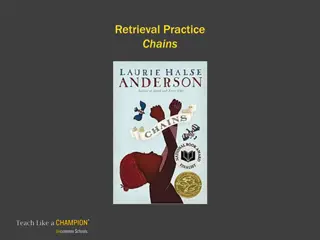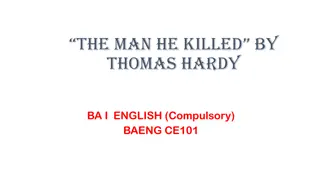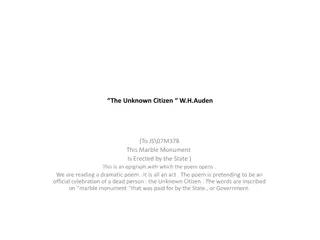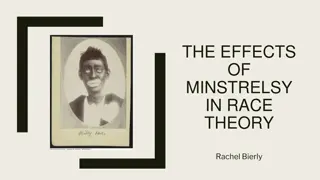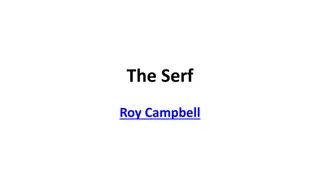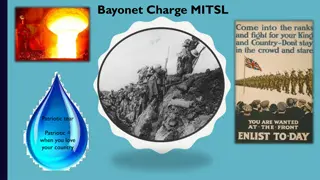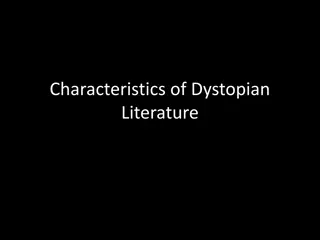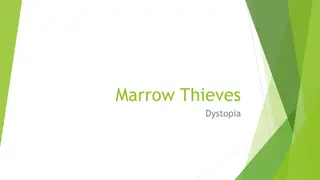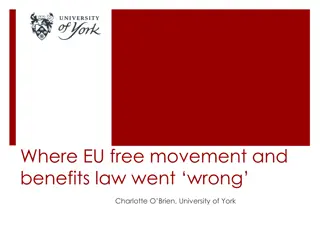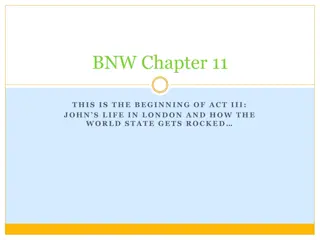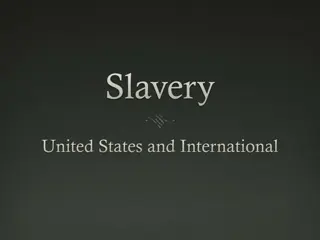The Eradication of the Black Body: A Critical Analysis
Michelle Cowin-Mensah's research delves into the performative aspects of terrorism, racial profiling, and the dehumanization of the black body. Through the lens of performance studies, she explores how societal behaviors perpetuate systemic injustice and erode the emotional relevance of black indivi
1 views • 12 slides
Retrieval Practice: American Revolution Lesson Insights
Explore key concepts such as Patriots, Loyalists, slave codes, manumission, and more from lessons on the American Revolution. Delve into the characters, actions, and historical context of the era through thought-provoking questions and answers. Understand the roles of individuals like Curzon and Abi
0 views • 23 slides
Analysis of "The Man He Killed" by Thomas Hardy and Its Historical Context
Thomas Hardy's poem "The Man He Killed" explores the senseless nature of war through the perspective of a soldier who reflects on killing an enemy soldier whom under different circumstances, they could have shared a drink with. Set during the Second Boer War, the poem highlights the arbitrary nature
0 views • 12 slides
Analysis of "The Unknown Citizen" by W. H. Auden
The poem "The Unknown Citizen" by W. H. Auden is a satirical commentary on modern society's dehumanization and loss of individual identity. Through the persona of an unnamed citizen reduced to a mere number, the poem critiques bureaucratic control, conformity, and the erasure of personal agency. The
0 views • 6 slides
Understanding Dystopian Societies in 1984 Novel Guide
Explore the themes of utopia and dystopia in George Orwell's 1984 novel through a comprehensive guide. Learn about the characteristics of dystopian societies, types of controls, and the role of protagonists in challenging oppressive systems. Dive into the discussions on propaganda, surveillance, deh
0 views • 10 slides
The Impact of Minstrelsy on Race Theory
The article explores the historical connection between minstrelsy, blackface, and race theory. It delves into the origins of minstrelsy, the use of blackface as a mask to mock authority, and how minstrel performances reinforced racial stereotypes, contributing to the dehumanization of African Americ
0 views • 11 slides
Thought-Provoking Reflections on Humanity & Society
Explore profound questions on discrimination, inaction, belongings, world change, hate, dehumanization, the possibility of a second Holocaust, and the irony of liberty through thought-provoking images and prompts, prompting examination of human behavior and societal norms.
0 views • 17 slides
Reflection on Psalm 22:1-31 - The Torture and Triumph of the Cross
The passage from Psalm 22 delves into the dual themes of lament and praise, highlighting the agony of the cross followed by the victorious accomplishment. It vividly portrays the suffering of Christ, showcasing the anguish and dehumanization he endured, juxtaposed with the salvation and humanization
0 views • 26 slides
The Serf by Roy Campbell - Analysis of Oppression and Suffering
Explore Roy Campbell's poem "The Serf" depicting the plight of oppressed laborers and the symbolism behind the imagery of mist, ploughing, and the scars on the serf's heart. The poem portrays the struggles and dehumanization of the serf class under oppressive masters.
0 views • 18 slides
Analysis of "Bayonet Charge" Poem by Ted Hughes
The analysis discusses how soldiers are manipulated into war, dehumanized, and forced to confront the harsh reality of combat in Ted Hughes' poem "Bayonet Charge." Through vivid imagery and language, the poem portrays the horrors of war and the impact on individuals caught up in its violence, sheddi
0 views • 14 slides
Understanding Dystopian Literature: Key Characteristics and Examples
Explore the characteristics of dystopian literature, including societal control, propaganda, surveillance, dehumanization, and the worship of figures or concepts. Learn how dystopias critique current trends and political systems through imagined oppressive worlds. Discover examples from popular dyst
0 views • 17 slides
Exploring Dystopian Worlds in Literature
Marrow Thieves presents a dystopian universe where societal control is oppressive. Dystopias criticize current trends by exaggerating worst-case scenarios. Characteristics include propaganda, limited freedom, and dehumanization. Types of control range from corporate to technological. Dystopian prota
0 views • 15 slides
Challenges of EU Free Movement and Benefits Law
Analysis of where the EU's free movement and benefits laws faced challenges, including issues with migration patterns, benefit claims, changes in regulations, and disregard of empirical evidence. The impact of punitive changes, dehumanization, and political campaigns on EU nationals is examined, hig
0 views • 10 slides
Exploring Themes of Bullying and Dehumanization in BNW Act III: John's Life in London
In this segment of BNW Act III, we delve into John's experience in London through references to Shakespeare's "The Tempest". Explore the parallels between John and Caliban, highlighting the impact of societal treatment on one's behavior and identity. The aftermath of Chapter 10 reveals the consequen
0 views • 35 slides
History of Slavery in the United States and Internationally
Slavery in the United States and internationally has a complex history, starting in the colonies with indentured servants and evolving into harsh chattel slavery. The Triangle Trade enriched Europeans at the expense of enslaved Africans, leading to a brutal system that destroyed families and culture
0 views • 8 slides
The Pedestrian by Ray Bradbury - Analysis and Themes
The story follows Mr. Leonard Mead, who loves walking the city streets at night in a totalitarian society set in 2053. He encounters a police car that stops him, leading to themes of dehumanization through technology, the impact of television, and loneliness. Through detailed textual analysis, the s
0 views • 18 slides

